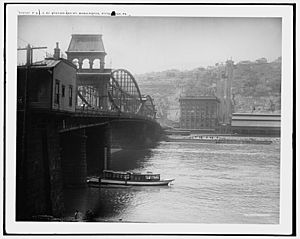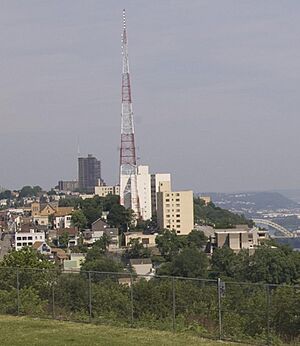Mount Washington, Pittsburgh (mountain) facts for kids
Quick facts for kids Mount Washington |
|
|---|---|
 |
|
| Highest point | |
| Geography | |
| Location | Pittsburgh |
Mount Washington is a famous hill in Pittsburgh, Pennsylvania. It sits on the southern banks of the Monongahela River and Ohio River. Many people visit Mount Washington to see its amazing views of the city below.
Contents
Mount Washington's Past
Long ago, in the early days of Pittsburgh, this hill was called Coal Hill. It was named this because it had lots of coal. People could easily get to the Pittsburgh coal seam (a layer of coal) near the bottom of the hill. This meant many mines could dig for coal there. Workers also cut out large rocks, like gray sandstone, from the hill. This stone was used to build important places, such as the second Allegheny County Courthouse.
By 1876, the name of the hill was changed to Mount Washington. Just a year later, artists began drawing the beautiful view of Pittsburgh from this spot. Today, many famous photos of the Pittsburgh skyline are taken from Mount Washington. This is because the hill is very high, looking down over the river valley and Downtown Pittsburgh.
Cool Cable Cars: The Inclines

Imagine trying to climb a very steep hill every day! That's what people living on Mount Washington had to do a long time ago. The paths up the hill were very difficult, even for horses pulling wagons. Many people who moved to Mount Washington in the early 1800s were from Germany. They worked in factories near the Monongahela River. After work, they were tired of climbing steep paths and steps to get home.
They remembered the "standseilbahns" (which means inclines or cable cars) from their home country. So, they decided to build some here! The Monongahela Incline was the first one, built between 1869 and 1870. The Duquesne Incline opened in May 1877. These inclines were like special elevators that moved up and down the steep hillside. They carried people and even some goods to the homes at the top of the hill.
Today, the Monongahela and Duquesne Inclines are still working! They offer amazing views of downtown Pittsburgh. Tourists love riding them to see the city. For many people who live on Mount Washington, these inclines are still the best way to get to their jobs, go shopping, or enjoy entertainment in downtown Pittsburgh and Station Square.
The Famous Pittsburgh Sign
In the 1930s, a huge neon sign was put up on the side of Mount Washington. It was very big, about 226 feet wide and 30 feet high! Companies like Iron City Beer and Clark's Teaberry Gum advertised on it first.
In 1967, the Alcoa aluminum company took over the sign. They changed its plain background to a cool gray-and-white pattern. This pattern spelled out "PITTSBURGH" when you saw it during the day! Alcoa was the most famous advertiser on the sign, staying there for 25 years. Later, other companies like Bayer AG also used the sign.
In 2016, a new vinyl sign was put over the old neon one. It said "Pittsburgh WINS with Black & Yellow". Many people from Pittsburgh didn't like this because the city's colors are usually called "black & gold". In 2019, the sign changed again. It now shows an American flag, representing the National Flag Foundation. What will happen to the old neon "Pittsburgh" sign in the future is still a mystery!
Tunnels Under the Mountain
Mount Washington isn't just famous for what's on top; it also has many tunnels running through it!
- The first tunnel was the Pittsburgh and Castle Shannon Tunnel. It started as a coal mine and was extended in 1861.
- Then came the Mount Washington Transit Tunnel and the Wabash Tunnel, both opening in 1904. The transit tunnel is still used by Pittsburgh Light Rail trains today.
- The Liberty Tunnel opened in 1928, making it easier for cars to travel through the mountain.
- Finally, the Fort Pitt Tunnel opened in 1960. This tunnel goes right under the Monongahela River and through Mount Washington, leading directly into downtown Pittsburgh.
Gallery


